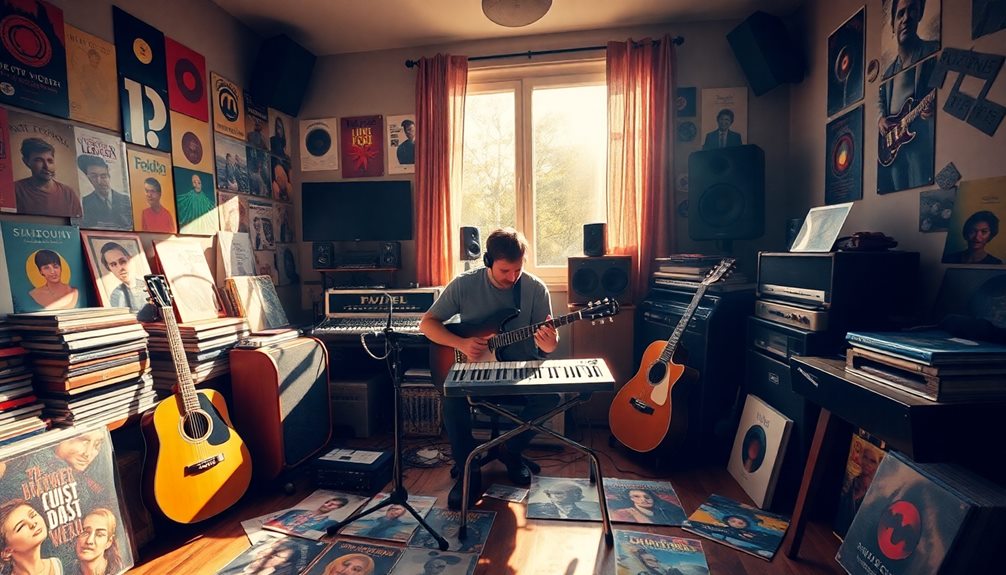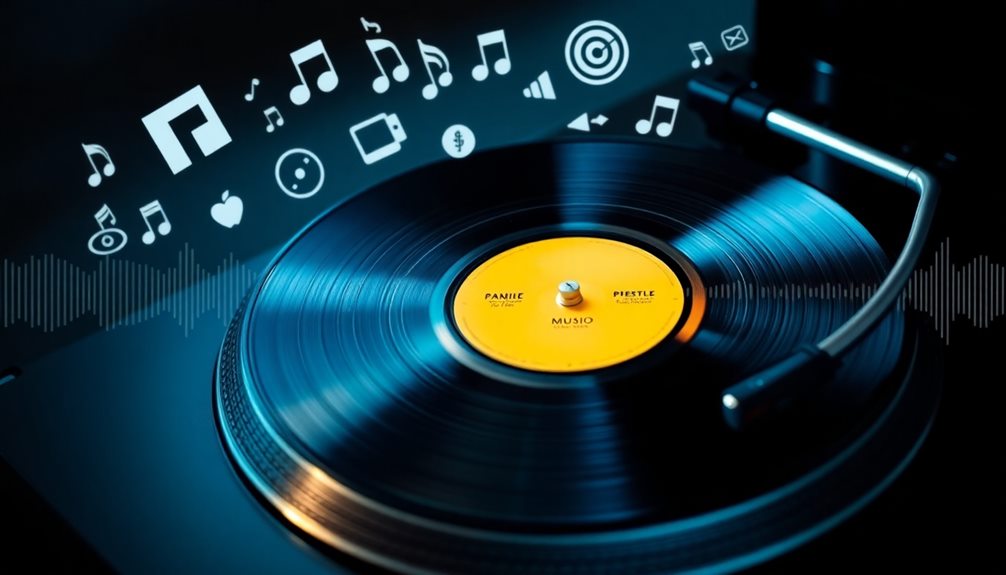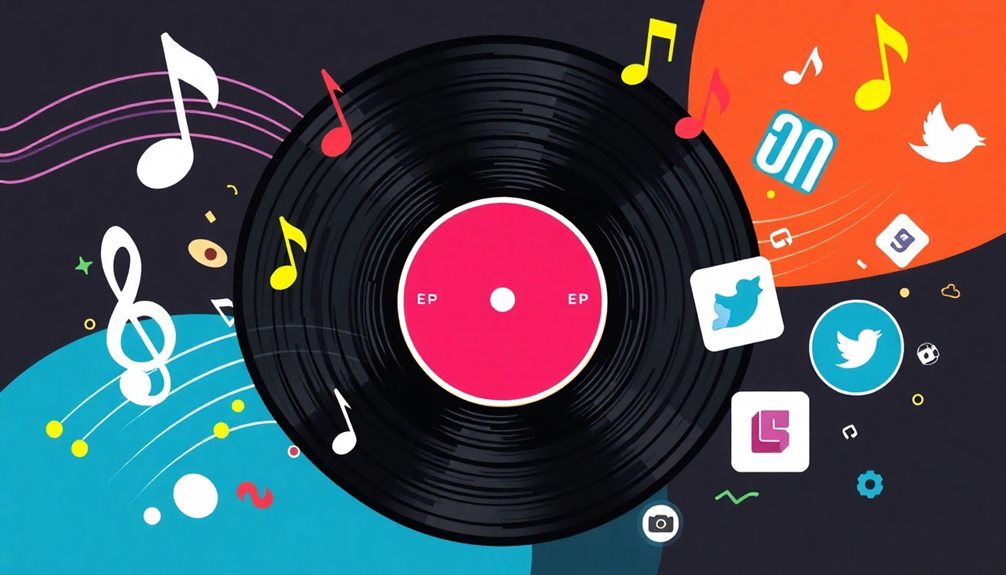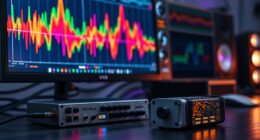An EP, or Extended Play, is a fun music release that usually has 4 to 6 tracks, making it a great way for you to explore an artist's style without diving into a full album. EPs are under 30 minutes long and serve as a bridge between singles and complete albums. They're perfect for emerging artists to share new sounds and connect with fans. With the rise of streaming, EPs have become super popular because they let artists experiment and build excitement. If you stick around, you'll discover even more about how EPs fit into the music world!
Key Takeaways
- An EP, or Extended Play, typically contains 4 to 6 tracks and lasts under 30 minutes on Spotify.
- EPs serve as a bridge between singles and full-length albums, allowing artists to share new music without full commitment.
- The format has evolved from physical releases to digital distribution, enhancing accessibility for independent artists on platforms like Spotify.
- EPs are often used as marketing tools to engage audiences, generate buzz, and test new sounds before a full album release.
- Streaming revenue from EPs can significantly impact artists, with platforms like Spotify offering payment per stream that encourages frequent releases.
Definition of an EP
If you've ever stumbled upon an EP on Spotify, you might wonder what it really is. An EP, or Extended Play, is like a little treasure chest of music. Typically, it contains 4 to 6 tracks, making it longer than a single but shorter than a full-length album. This format usually lasts under 30 minutes, which is perfect for artists who want to share new songs without the big commitment of a full album.
You'll find that the music industry has embraced EPs, especially among independent artists. They're a cost-effective way to stay connected with fans and keep the music flowing.
The term "EP" first popped up in the 1950s, created to describe releases that were longer than singles but shorter than those lengthy albums that are familiar to us today.
Purpose of Releasing EPs

Releasing an EP serves multiple purposes for artists, acting as a strategic tool in their musical journey. An EP in music is a cost-effective way to share new tracks with fans. Instead of committing to a full album, artists can release 4 to 6 tracks that showcase their style in under 30 minutes. This gives listeners a taste of what's to come!
For emerging artists, an EP acts like a bridge. It helps you build a fan base, gain traction, and create excitement before a full album release. It's a fantastic way to engage your audience without the pressure of a lengthy project.
Plus, digital platforms like Spotify make it easy for you to access these EPs instantly. You can enjoy new music and even track how well it's doing in real-time!
Releasing an EP not only generates buzz but also keeps your name visible in the music scene. It's a perfect way to keep fans excited and involved.
Evolution of the EP Format

Let's talk about how the EP format has changed over the years!
It started in the 1950s as a way for artists to share more than just one song, usually with 3 to 5 tracks.
Now, thanks to digital streaming, EPs are super important for musicians to connect with fans and share new music easily!
Historical Origins of EPs
How did the EP format come to be such an essential part of the music landscape? Well, it all started in the 1950s! The EP, which stands for Extended Play, emerged as a clever solution for musicians. At first, artists wanted a way to share more music than just one single, but they didn't want to commit to a whole album.
So, they created the EP, typically featuring 4 to 6 tracks, adding up to around 15 to 30 minutes in total. Initially released on vinyl, these records offered a perfect middle ground for artists and fans alike. They allowed musicians to showcase their talents without the pressure of a full album release.
Over time, EPs became popular, especially among independent musicians. They were cost-effective and helped artists connect with fans by releasing new music between full albums.
Today, the historical origins of EPs remind us of their important role in music promotion. They still adapt to changing times and help artists reach audiences in exciting ways.
Digital Streaming Impact
As music consumption shifted from physical formats to digital platforms, the EP format adapted to meet the changing landscape. You might wonder, what does EP mean in this situation? EPs, or Extended Plays, have evolved since the 1950s. Now, they're a fun way for artists to share 4 to 6 tracks, usually lasting under 30 minutes. This shorter format makes it easier for fans to enjoy new music without diving into a full album.
Streaming platforms like Spotify and Apple Music have opened up a world of possibilities for both new and established artists. With EPs, musicians can test new material and engage with their audience. The total duration of an EP makes it a perfect sneak peek into what's to come!
Thanks to the analytics on these platforms, artists can also track EP performance in real-time. This means they can see what songs fans love and adjust their marketing strategies accordingly. It's an exciting time for music lovers!
The accessibility of EPs helps emerging artists grow their fanbase, creating buzz for their future full-length albums. So next time you listen to an EP, remember how it fits into this vibrant digital world!
Current Usage Trends
The evolution of the EP format reflects a significant shift in how artists connect with their audiences today. Once a simple way to share a few songs, EPs have transformed into a powerful tool for musicians. Emerging artists find EPs especially valuable for building a fanbase. They can release new music without the pressure of a full album.
With the rise of streaming platforms like Spotify, the EP has become more popular. Typically, an EP contains 4 to 6 tracks with a total duration under 30 minutes. This shorter format fits perfectly with today's music consumption habits. Listeners often prefer quick, frequent releases rather than waiting for a long album.
Additionally, EPs serve as a smart marketing strategy. They create excitement and anticipation for future projects. Artists can also experiment with different sounds and styles, helping them grow creatively.
You might notice how some of your favorite new songs come from EPs. They're a great way for artists to stay connected to you! So, next time you see "EP" in the title, remember it's not just music; it's a chance for artists to share their creativity and keep you engaged.
Digital Distribution of EPs

When you think about getting your EP on Spotify, you'll want to know about the platforms that can help you, like DistroKid and TuneCore.
These services make it easy for you to share your music while keeping your ownership. By utilizing automation and streamlined processes, you can efficiently manage your releases and focus on creativity.
Plus, tracking how your EP is doing with Spotify's analytics can be really exciting as you see your audience grow!
EP Distribution Platforms
Steering through the world of EP distribution can greatly influence an artist's career, especially with platforms like Spotify making it easier than ever to share music.
When you release an EP, it's essential to choose the right distribution service. Here are three popular options:
- DistroKid – This platform lets you keep all your earnings and gets your EP on Spotify fast!
- TuneCore – Known for its broad reach, TuneCore helps you distribute your EP to many streaming services, including Spotify.
- CD Baby – A favorite among independent artists, CD Baby offers great support and keeps you in control of your music.
Streaming Revenue Impact
Releasing an EP on Spotify can have a substantial impact on your streaming revenue. EPs, which usually contain 4 to 6 tracks and last under 30 minutes, are a fantastic way to connect with your audience. With Spotify paying between $0.003 and $0.005 per stream, every play counts!
In 2022, Spotify generated over $11 billion, and you can tap into that by sharing your music. When you release an EP, you're not just putting out songs; you're increasing your visibility. More people discovering your music can lead to higher streaming numbers and, ultimately, more revenue.
Plus, Spotify provides helpful analytics that lets you track your EP's performance in real-time. This means you can see what works and make smart decisions for future projects.
For independent artists, releasing an EP is often cheaper than a full album. It's a cost-effective way to test new ideas and reach more listeners.
EPs also build excitement for upcoming albums. When your music is streamed successfully, it creates anticipation, keeping your fans engaged and ready for what's next!
Marketing Strategies for EPs

Marketing an EP effectively requires a solid strategy that resonates with your audience. To grab attention and build excitement, follow these three marketing strategies:
- Set a Release Date: Choose a specific date for your EP launch. This gives your fans something to look forward to and helps you plan your promotions effectively.
- Leverage Online Platforms: Use social media! Share sneak peeks, behind-the-scenes content, and engaging visuals on platforms like Instagram, TikTok, and Twitter. This boosts audience engagement and keeps your fans excited.
- Host a Release Party: Whether it's online or in person, a release party can create buzz. Invite fans to celebrate with you, listen to the EP together, and interact. This builds a community around your music.
Additionally, consider including a catchy lead track, maybe a remix of a popular song, to attract more listeners.
Collaborating with influencers can also broaden your reach, making sure your EP gets in front of the right audience.
SoundOn and EP Distribution

Steering through the complexities of EP distribution can be intimidating, but SoundOn simplifies the process for independent artists. With SoundOn, your EP can totally reach streaming platforms like Spotify and TikTok, making it easier for fans to find your music.
If you're recording a full EP, which is usually considered an EP if it has three to six songs, you can confidently choose a release title within the platform.
SoundOn helps you promote your EP with special marketing tools. These tools create excitement and buzz around your music, drawing in listeners who mightn't have discovered you otherwise.
Plus, you can track your EP's performance in real-time! This means you can see how many people are listening and make smart choices to connect with your audience.
Another great benefit is the lower distribution costs. This lets you keep more of your earnings while sharing your music with the world.
Frequently Asked Questions
What Does EP Mean in Spotify?
When you see "EP" on Spotify, it means you're looking at an Extended Play release. Typically, it features 4 to 6 tracks, offering a more substantial experience than a single without the commitment of a full album.
What Does EP Stand for in Music?
Imagine a bridge, connecting singles to full albums. That's where an EP stands. It's an Extended Play, a compact collection of tracks that lets you explore an artist's creativity without diving into an entire album.
Is 7 Songs an EP?
No, seven songs isn't an EP. It exceeds the typical track limit for that format. If you're looking for a concise release, consider sticking to four to six tracks for it to qualify as an EP.
What Do EP and LP Mean in Music?
In music, EP stands for Extended Play, featuring 4 to 6 tracks, while LP means Long Playing, containing 7 or more. EPs offer a taste of an artist's work without a full album commitment.
Conclusion
Now you know what an EP is and why artists love releasing them! It's a fun way to share new music without creating a whole album. Did you know that over 30% of Spotify users listen to EPs regularly? That's a lot of happy listeners enjoying shorter tracks! So, next time you see "EP" on Spotify, you'll understand it's all about exploring fresh sounds and connecting with your favorite artists. Happy listening!









